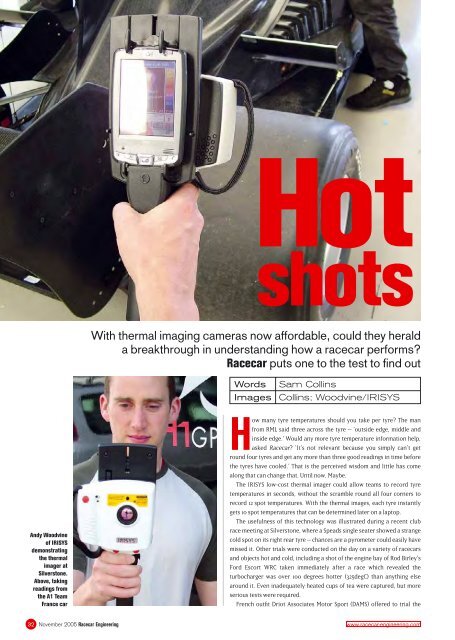Racecar Engineering - November 2005
Racecar Engineering - November 2005
Racecar Engineering - November 2005
Create successful ePaper yourself
Turn your PDF publications into a flip-book with our unique Google optimized e-Paper software.
Hot<br />
shots<br />
With thermal imaging cameras now affordable, could they herald<br />
a breakthrough in understanding how a racecar performs?<br />
<strong>Racecar</strong> puts one to the test to fi nd out<br />
Words<br />
Images<br />
Sam Collins<br />
Collins; Woodvine/IRISYS<br />
Andy Woodvine<br />
of IRISYS<br />
demonstrating<br />
the thermal<br />
imager at<br />
Silverstone.<br />
Above, taking<br />
readings from<br />
the A1 Team<br />
France car<br />
How many tyre temperatures should you take per tyre? The man<br />
from RML said three across the tyre – ‘outside edge, middle and<br />
inside edge.’ Would any more tyre temperature information help,<br />
asked <strong>Racecar</strong>? ‘It’s not relevant because you simply can’t get<br />
round four tyres and get any more than three good readings in time before<br />
the tyres have cooled.’ That is the perceived wisdom and little has come<br />
along that can change that. Until now. Maybe.<br />
The IRISYS low-cost thermal imager could allow teams to record tyre<br />
temperatures in seconds, without the scramble round all four corners to<br />
record 12 spot temperatures. With the thermal images, each tyre instantly<br />
gets 10 spot temperatures that can be determined later on a laptop.<br />
The usefulness of this technology was illustrated during a recent club<br />
race meeting at Silverstone, where a Speads single seater showed a strange<br />
cold spot on its right rear tyre – chances are a pyrometer could easily have<br />
missed it. Other trials were conducted on the day on a variety of racecars<br />
and objects hot and cold, including a shot of the engine bay of Rod Birley’s<br />
Ford Escort WRC taken immediately after a race which revealed the<br />
turbocharger was over 100 degrees hotter (325degC) than anything else<br />
around it. Even inadequately heated cups of tea were captured, but more<br />
serious tests were required.<br />
French outfit Driot Associates Motor Sport (DAMS) offered to trial the<br />
32 <strong>November</strong> <strong>2005</strong> <strong>Racecar</strong> <strong>Engineering</strong><br />
www.racecar-engineering.com

















